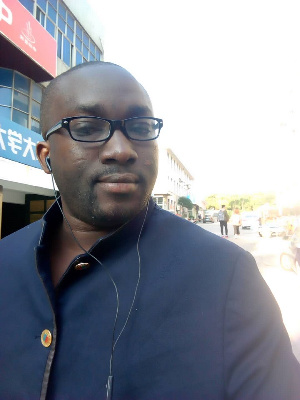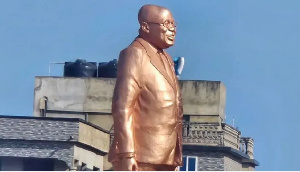Opinions of Monday, 3 June 2019
Columnist: Mark Yama Tampuri Jnr
Ghana's central bank closes down 72% of its microfinance firms permanently: What's next?
The Bank of Ghana (BoG), Ghana`s central bank and regulator of the banking sector has revoked the license of 347 (72%) of its total microfinance institutions: Thus some 192 insolvent microfinance firms while another 155 microfinance firms which have ceased operations have also had their license revoked ``pursuant to section 123(1) of the Banks and Specialized Deposit-Taking Institution Act, 2016 (Act 930).
The BoG has powers to revoke the license of Banks and Specialized Deposit Taking Institution which are either insolvent or likely to be insolvent within the period of 60 days after making such determination.
The revocation of the license by the BoG in accordance with the laws governing the sector took effect after several opportunities given to these institutions to address their insolvencies and other regulatory commitments.
Having held the view that the BOG is partly to be blamed for their lack of effective supervision till date, it is just right time they move to sanitize the sector.
It would be recalled that similar exercise by the regulator in 2018 saw some banking institutions either had their license revoked, merged or change their status from a bank to microfinance institutions in a different situation.
This cleanup of the sector described as spring-clean is strengthening the sector with better prospects for lending activities. This was preceded in 2017 by a tripling of the capital requirement to minimize the impact of shocks and protect lenders.
After the exercise to clean up the banking sector in 2018 which brought the number of banks from 34 to 23, much is yet to be seen done by BOG to sanitize especially the sector for Microfinance institutions.
Assuring however is that depositors of the 347 Microfinance Firms have their deposits safe as the Bank of Ghana has secured GHS 900M to pay for claims of depositors: but of course after the validation of claims by the receiver appointed to take charge of the process in accordance to the Act 930.
The amount secured by the BoG As a matter of concern is just a little fraction of the GHS 7B debt crisis the sub-sector of deposit taking and non-deposit taking financial institution in the country.
The assets of the firms would be determined a receiver appointed in accordance with section 123 (2) of ACT 930. Therefore the assets and liabilities of these windup firms would be determined. Depositors will not in any way part with their monies as a result of the actions by the Central bank.
I happen to hold concerns in this particular sector of the financial economy. This has been long overdue especially so when most of these financial institutions were never likely to become solvent.
But more of a concern for which BoG needs to be commended is because most of these microfinance institutions have ceased operations, locked up their offices, therefore locking up depositors funds and in most cases without regards to the BoG.
This is highly Unacceptable in the regulator sector as such. The major cause for concerns is those I list below which holds for all the financial institutions whose license had been revoked: The sector has been a total mess.
1: Insolvent and bad books: These microfinance companies are highly insolvent and very likely to be worse off in the coming days. It is envisaged that within the next 60 days, the institutions are highly unlike to be in any better position than they find themselves as at now, hence the need to revoke their license. Indeed one would say why not the regulator gives them more time? This may be a justifiable question, though it must be noted that most of these microfinance institutions have never been solvent, and never truly recapitalized. They happened to have still had their license because the BoG has been sleeping over their jobs.
2. Financial institutions that only exist in books but ceased operations; Most of these financial institutions only existed in books with their names. Practically, on the grounds, nothing was seen or heard about them whiles some customers still held their funds with these struggling institutions with branches closed.
3) Financial institutions diverting funds to other investments other done their core responsibilities: Sadly as it may be, some of these financial institutions if not most rather done concentrating on their core mandates were rather busy investing in non-related businesses that one could think of as including bottled water business, car rental business etc as apparently ventured into by powers associated with them.
4) High-interest rates: Microfinance institutions are very important firms to propel economic activities to low-income earners. This usually is so because they offer debt financing to individuals and firms for economic activities. There have been success stories emanating from the operations of microfinance firms. This is even more recognized when interest rates are moderate enough for these low-end income earners. This,however, is not the case for most microfinance institutions with some taking up to 40-50% interest per annum on principal. This could only have two prominent outcomes: firstly business cannot make any profit with such interest rates on monies borrowed and some ultimate default. Of course, the moderate ones are loan delinquencies. Either way, this type of operations is alien to the concept of microfinance and this is a concern in the sector in Ghana.
5) objects for money laundering: Another concern in the sector is that most of these institutions which were still holding their license but practically non-existent could potentially be instrumental in money laundering because of their connection to the financial sector that makes inflows and outflows of funds possible through them under the shed of doing business. A clampdown of these financial institutions and revoking their license can forestall such.
The Way Forward:
Many have commended the regulator for waking from their sleep and now taking up their responsibilities. However, BoG, being called upon to not only concentrates on punitive measures only for non-conforming microfinance for institutions but as well as support especially those good institutions that have continued to and has remain solvent. The publications of the names of the 155 remaining microfinance in good standing would go a long way to bring confidence to the sector.
The regulator needs to step up their supervision of the remaining 155 microfinance firms. Specifically, the supervision department of the BoG must be resourced to undertake their responsibilities more effectively.
Also, the BoG should not only encourage mergers of the remaining firms, technical and financial support should be available to these institutions to tap in and improve on their corporate governance. A good way to go about this is to take effect in law to increase the capital requirement for microfinance intuitions. This would trigger more investment in the firms and possible mergers to make them stronger.
Lastly, the BoG would have to constantly communicate with the public on these issues without fail. For these regulatory actions to be accepted by all, then it beholds on the central bank to up their communication on them. the microfinance sub-sector of the financial sector is highly volatile with regards to stakeholders there. Very common are mostly low-income earners as well as a lot of businesses within the informal sectors are served here. Being a sub-sector that is highly speculative and with history of runaway firms which folded up after taking monies from customers, communication should be very essential to assure stakeholders especially depositors of the process.
What we envisage a vibrant microfinance subsector with firms that are economically viable and trusted to perform their corporate responsibilities to support the economy.
By Mark Yama Tampuri Jnr| Ph.D. Candidate of Management Science and Engineering | Jiangsu University, China
Entertainment










